名词解释1
名词解释1

1.丙氨酸-葡萄糖循环肌肉中的氨基酸将氨基转给丙酮酸生成丙氨酸,后者经血液循环转运至肝脏经过联合脱氨基作用再脱氨基,放出的氨用于合成尿素;生成的丙酮酸经糖异生转变为葡萄糖后再经血液循环转运至肌肉重新分解产生丙酮酸,丙酮酸再接受氨基生成丙氨酸。
丙氨酸和葡萄糖反复地在肌肉和肝之间进行氨的转运,股将这一循环过程称为丙氨酸-葡萄糖循环。
2.光合磷酸化光合磷酸化(photophosphorylation)是植物叶绿体的类囊体膜或光合细菌的载色体在光下催化腺二磷(ADP)与磷酸(Pi)形成腺三磷(ATP)的反应。
3.底物水平磷酸化物质在生物氧化过程中,常生成一些含有高能键的化合物,而这些化合物可直接偶联ATP 或GTP的合成,这种产生ATP等高能分子的方式称为底物水平磷酸化4.酶的共价修饰调节某些酶蛋白肽链上的侧链基团在另一酶的催化下可与某种化学基团发生共价结合或解离,从而改变酶的活性,这一调节酶的活性的方式成为酶的共价修饰调节5.酮体在肝脏中,脂肪酸氧化分解的中间产物乙酰乙酸、β-羟基丁酸及丙酮,三者统称为酮体。
肝脏具有较强的合成酮体的酶系,但却缺乏利用酮体的酶系。
酮体是脂肪分解的产物,而不是高血糖的产物。
进食糖类物质也不会导致酮体增多。
6.P/O比值物质氧化时,每消耗1克原子氧所消耗无机磷的摩尔数(或ATP摩尔数),即生成ATP的克分子数7.脂肪酸的β-氧化脂酰CoA在线粒体基质中进入β氧化要经过四步反应,即脱氢、加水、再脱氢和硫解,生成一分子乙酰CoA和一个少两个碳的新的脂酰CoA。
8.暗反应暗反应是激发分子的热力学的缓和过程,是电荷的分离、电子的传递、磷酸化或短命的中间体形成等多种基本过程。
9.光反应光反应又称为光系统电子传递反应(photosythenic electron-transfer reaction)。
在反应过程中,来自于太阳的光能使绿色生物的叶绿素产生高能电子从而将光能转变成电能。
10.转氨基作用指的是一种α-氨基酸的α-氨基转移到一种α-酮酸上的过程。
名词解释1——精选推荐
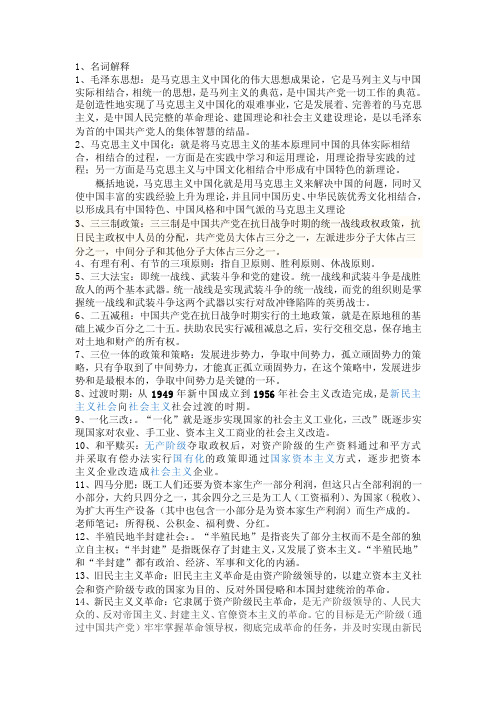
1、名词解释1、毛泽东思想:是马克思主义中国化的伟大思想成果论,它是马列主义与中国实际相结合,相统一的思想,是马列主义的典范,是中国共产党一切工作的典范。
是创造性地实现了马克思主义中国化的艰难事业,它是发展着、完善着的马克思主义,是中国人民完整的革命理论、建国理论和社会主义建设理论,是以毛泽东为首的中国共产党人的集体智慧的结晶。
2、马克思主义中国化:就是将马克思主义的基本原理同中国的具体实际相结合,相结合的过程,一方面是在实践中学习和运用理论,用理论指导实践的过程;另一方面是马克思主义与中国文化相结合中形成有中国特色的新理论。
概括地说,马克思主义中国化就是用马克思主义来解决中国的问题,同时又使中国丰富的实践经验上升为理论,并且同中国历史、中华民族优秀文化相结合,以形成具有中国特色、中国风格和中国气派的马克思主义理论3、三三制政策:三三制是中国共产党在抗日战争时期的统一战线政权政策,抗日民主政权中人员的分配,共产党员大体占三分之一,左派进步分子大体占三分之一,中间分子和其他分子大体占三分之一。
4、有理有利、有节的三项原则:指自卫原则、胜利原则、休战原则。
5、三大法宝:即统一战线、武装斗争和党的建设。
统一战线和武装斗争是战胜敌人的两个基本武器。
统一战线是实现武装斗争的统一战线,而党的组织则是掌握统一战线和武装斗争这两个武器以实行对敌冲锋陷阵的英勇战士。
6、二五减租:中国共产党在抗日战争时期实行的土地政策,就是在原地租的基础上减少百分之二十五。
扶助农民实行减租减息之后,实行交租交息,保存地主对土地和财产的所有权。
7、三位一体的政策和策略:发展进步势力,争取中间势力,孤立顽固势力的策略,只有争取到了中间势力,才能真正孤立顽固势力,在这个策略中,发展进步势和是最根本的,争取中间势力是关键的一环。
8、过渡时期:从1949年新中国成立到1956年社会主义改造完成,是新民主主义社会向社会主义社会过渡的时期。
9、一化三改:。
名词解释1
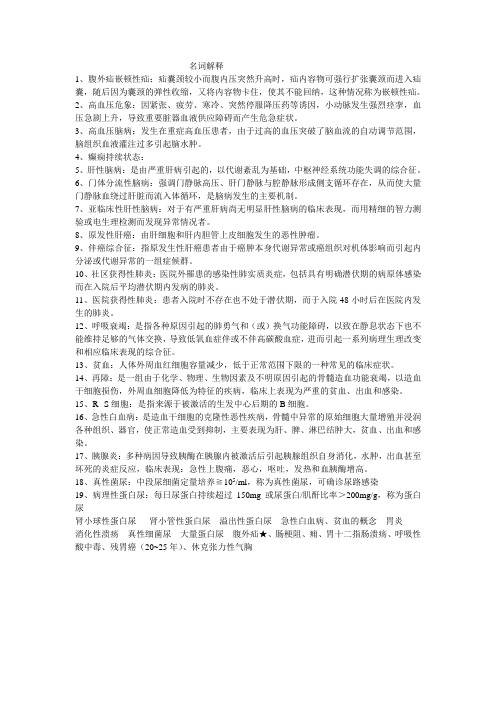
名词解释1、腹外疝嵌顿性疝:疝囊颈较小而腹内压突然升高时,疝内容物可强行扩张囊颈而进入疝囊,随后因为囊颈的弹性收缩,又将内容物卡住,使其不能回纳,这种情况称为嵌顿性疝。
2、高血压危象:因紧张、疲劳、寒冷、突然停服降压药等诱因,小动脉发生强烈痉挛,血压急剧上升,导致重要脏器血液供应障碍而产生危急症状。
3、高血压脑病:发生在重症高血压患者,由于过高的血压突破了脑血流的自动调节范围,脑组织血液灌注过多引起脑水肿。
4、癫痫持续状态:5、肝性脑病:是由严重肝病引起的,以代谢紊乱为基础,中枢神经系统功能失调的综合征。
6、门体分流性脑病:强调门静脉高压、肝门静脉与腔静脉形成侧支循环存在,从而使大量门静脉血绕过肝脏而流入体循环,是脑病发生的主要机制。
7、亚临床性肝性脑病:对于有严重肝病尚无明显肝性脑病的临床表现,而用精细的智力测验或电生理检测而发现异常情况者。
8、原发性肝癌:由肝细胞和肝内胆管上皮细胞发生的恶性肿瘤。
9、伴癌综合征:指原发生性肝癌患者由于癌肿本身代谢异常或癌组织对机体影响而引起内分泌或代谢异常的一组症候群。
10、社区获得性肺炎:医院外罹患的感染性肺实质炎症,包括具有明确潜伏期的病原体感染而在入院后平均潜伏期内发病的肺炎。
11、医院获得性肺炎:患者入院时不存在也不处于潜伏期,而于入院48小时后在医院内发生的肺炎。
12、呼吸衰竭:是指各种原因引起的肺勇气和(或)换气功能障碍,以致在静息状态下也不能维持足够的气体交换,导致低氧血症伴或不伴高碳酸血症,进而引起一系列病理生理改变和相应临床表现的综合征。
13、贫血:人体外周血红细胞容量减少,低于正常范围下限的一种常见的临床症状。
14、再障:是一组由于化学、物理、生物因素及不明原因引起的骨髓造血功能衰竭,以造血干细胞损伤,外周血细胞降低为特征的疾病,临床上表现为严重的贫血、出血和感染。
15、R--S细胞:是指来源于被激活的生发中心后期的B细胞。
16、急性白血病:是造血干细胞的克隆性恶性疾病,骨髓中异常的原始细胞大量增殖并浸润各种组织、器官,使正常造血受到抑制,主要表现为肝、脾、淋巴结肿大,贫血、出血和感染。
名词解释1
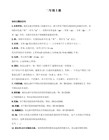
13、无句读:旧版古籍无句读的标志,更没有分词成语:是经过冶炼、长期习用而流传下来的固定词语,具有高度概括性。
15、典故:古诗文多用典,或称“用事”,以增强文章的说服力。
6、异体字:是读音和意义完全相同,可以通用的外形不同的字。
7、讹误字:是古书在反复传抄过程中,形体相近的字很容易混同造成。
8、形讹:就是某字在传写中误写成了形体相近的另一个字,使文意难通。
9、衍文:指典籍传抄翻刻中多了文字。
10、脱文:指典籍传抄翻刻中漏掉的文字。
11、错简:指典籍段落或者文句的次序颠倒错乱。
51、右文说:宋王子韶(圣美)所创,主张由声符推求语义,认为“声中有义”;朦胧意识到“声中有义”,有一定积极意义,但存在严重缺陷,主要是过分拘泥于字形。
52、同源词:由同一根词派生出来,因而音义皆近、音近义同或义近音同的词。
53、推求语源:主要是从同源词中广泛系联派生词,即确定同源派生词之间的关系。
63、义界(标明义界):是用下定义的方式来表述词义的内容和特点。
64、描写:即对词所表示的事物的形状、性能等加以描述。
65、譬况:用熟知的事物去比方类似的不熟知的事物。
66、比较:即通过对比来释明意义相近或相关的词。
67、举例:即举其一,以见其他。
68、由反知正:这是用反义词加上否定词来阐明词义。
16、古译语:即音译的外来语。
17、词义的增加:指本义引申出新义后,本义在后代仍然使用,词的义项多起来了。
18、词义的减少:指原来不止一个意义,后来其中某些意义逐渐消失了。
名词解释 (1)
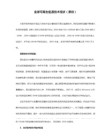
4、美术片:电影四大片种之一。美术片:是动画片、木偶片、剪纸片、折纸片的总称。。它以绘画或其他造型形式作为人物造型和环境空间造型的主要表现手段,不追求故事片的逼真性特点,而运用夸张,神似,变形的手段,借助于幻想,想象和象征,反映人们的生活,理想和愿望是一种高度假定性的艺术。美术电影一般采用逐格拍摄方法把一系列分解为若干环节的动作一次拍摄下来,连续放映时时便在银幕上产生活动的影像。区别于故事片、纪录片的电影形式:1.影片中的形象和背景使用绘画、雕塑等美术手段创造出来的。2.这类影片使用逐格方式摄制的。
26、电影思维:已设思维一种特殊形式,指为创作影片影片所进行的与未来银幕形象有直接关联的思维活动。其基本特征是——对未来影片放映效果的预见性,支配者正常思维过程,最大限制发挥电影特性的要求,制约着整个地位过程,这种思维是参与整个影片时机制作的全体人员—编剧、导演、演员、摄影师、美术设计师、音乐录音设计师、剪辑设计师等,协同进行的一场复杂的精神活动。
24、赛璐珞片:塑料的一种,透明,课染成各种颜色,在动画片制作中式很重要的素材,为作品本身着色。将铅笔画稿描绘道透明的赛璐珞胶片上,并着以颜色,然后与彩色背景丢放在一起用摄影机一张一张拍摄,从而形成连续的图像、就是动画片的基本原理。
25、色指定:根据色彩设定来指定具体用色。这类工具是在动画上进行标注,还要指定赛璐珞片着色所需的阴影,层次色以及所使用的颜色边旁。
11、先期录音:是指先录音后绘制画片,后期录音指先设置画
面后录音
12、个性动画片:一般是指这样的影片,它与以创造商业价值为目的的影院片和系列片相对应,篇幅较短不强调故事结构完整;从编剧、导演制作往往是有个人包揽或几个志同道合的人共同参与;在动画技巧上进行有目的探索,在动画语言有鲜明的个性;主题,内涵最求某种耐人寻味的思考。
名词解释1

1特种设备的定义:指涉及生命安全、危险性较大的锅炉、压力容器(含气瓶,下同)、压力管道、电梯、起重机械、客运索道、大型游乐设施和场(厂)内专用机动车辆。
、2.电梯:是指动力驱动,利用沿刚性导轨运行的箱体或沿固定线路运行的梯级(踏步),进行升降或平行运送人、货物的机电设备,包括载人电梯,自动扶梯、自动人行道(G7024:服务于建筑物内若干特定楼层,其轿厢运行在至少两列垂直于水平或与铅垂线倾斜角小于15°的刚性导轨运动的永久运输设备。
)3.限速器:电梯的运行速度超过额定速度一定值时,其动作能够切断安全回路或进一步导致安全钳或上行超速保护装置起作用,是电梯减速直到停止的自动安全装置。
4.安全钳:使轿厢或对重制停在导轨上的机械装置5.对重:位于井道内,通过曳引绳经曳引轮与轿厢连接,在电梯的运行过程中保持曳引能力的装置、6特种设备检验人员的主要职责:在资格证书允许的范围内从事相应的检验工作;编制检验方案;出具检验报告,并对检验结果负责。
7安全特低电压:安全电压,不致使人直接致死或致残的电压。
一般环境条件下允许的持续接触的安全特低电压是50v 8.tn-s系统通常称三相五线制。
由三根项线一根中线N和一根保护线PE组成9.安全系数:装有额定载荷的轿厢停靠在最底层站时,一根钢丝绳的最小破断载荷(n)与这根钢丝绳所受到的最大力(N)之间的的比值。
10.钢丝绳的最小破断载荷:钢丝绳公称截面积(mm的平方)和钢丝绳公称抗拉强度与一定结构钢丝绳最小破断载荷换算系数的连乘积。
11.限速器:当电梯运行速度超过额定速度一定值时,其动作能导致安全钳起作用的安全装置。
12.安全触点:在动作时应由装置将其可靠断开,甚至触电熔接在一起也能断开,所以使用安全触电就可以不考虑触点不断开可能造成的危险。
13.平衡重:为节能而设置的平衡全部和部分轿厢自重的质量。
14.爆炸极限:可燃气体与空气混合形成可爆炸的混合物中可燃气体的浓度范围。
名词解释1
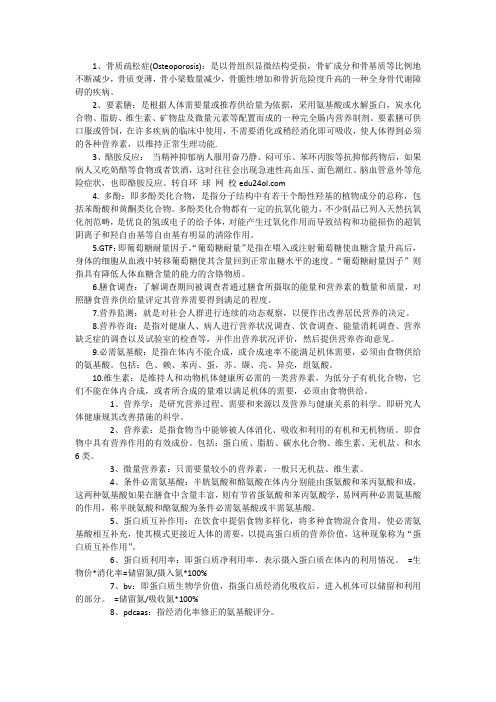
1、骨质疏松症(Osteoporosis):是以骨组织显微结构受损,骨矿成分和骨基质等比例地不断减少,骨质变薄,骨小梁数量减少,骨脆性增加和骨折危险度升高的一种全身骨代谢障碍的疾病。
2、要素膳:是根据人体需要量或推荐供给量为依据,采用氨基酸或水解蛋白,炭水化合物、脂肪、维生素、矿物盐及微量元素等配置而成的一种完全肠内营养制剂。
要素膳可供口服或管饲,在许多疾病的临床中使用,不需要消化或稍经消化即可吸收,使人体得到必须的各种营养素,以维持正常生理功能.3、酪胺反应:当精神抑郁病人服用奋乃静、闷可乐、苯环丙胺等抗抑郁药物后,如果病人又吃奶酪等食物或者饮酒,这时往往会出现急速性高血压、面色潮红、脑血管意外等危险症状,也即酪胺反应。
转自环球网校4. 多酚:即多酚类化合物,是指分子结构中有若干个酚性羟基的植物成分的总称,包括苯酚酸和黄酮类化合物。
多酚类化合物都有一定的抗氧化能力,不少制品已列入天然抗氧化剂范畴,是优良的氢或电子的给予体,对能产生过氧化作用而导致结构和功能损伤的超氧阴离子和羟自由基等自由基有明显的清除作用。
5.GTF:即葡萄糖耐量因子。
“葡萄糖耐量”是指在喂入或注射葡萄糖使血糖含量升高后,身体的细胞从血液中转移葡萄糖使其含量回到正常血糖水平的速度。
“葡萄糖耐量因子”则指具有降低人体血糖含量的能力的含铬物质。
6.膳食调查:了解调查期间被调查者通过膳食所摄取的能量和营养素的数量和质量,对照膳食营养供给量评定其营养需要得到满足的程度。
7.营养监测:就是对社会人群进行连续的动态观察,以便作出改善居民营养的决定。
8.营养咨询:是指对健康人、病人进行营养状况调查、饮食调查、能量消耗调查、营养缺乏症的调查以及试验室的检查等,并作出营养状况评价,然后提供营养咨询意见。
9.必需氨基酸:是指在体内不能合成,或合成速率不能满足机体需要,必须由食物供给的氨基酸。
包括:色、赖、苯丙、蛋,苏、缬、亮、异亮,组氨酸。
10.维生素:是维持人和动物机体健康所必需的一类营养素,为低分子有机化合物,它们不能在体内合成,或者所合成的量难以满足机体的需要,必须由食物供给。
名词解释 1

二、名词解释1.政治思想政治思想就是适应一定时代需要,反映一定社会阶级、阶层或集团利益的政治理想、政治态度和政治要求,为其设计夺取、建立和维护政治统治的方案和为实现其统治出谋献策。
政治思想的核心问题始终是国家政权问题,因此如何认识国家、组织国家、管理(治理)国家是政治思想的主要内容。
它集中表现为各种政治观点、政治主张和政治学说。
2.苏格拉底对希腊政治思想作出重大贡献的思想家。
苏格拉底是智者们的同时代人。
他与智者一起,推动了希腊哲学研究兴趣的转向,即由自然转向人和社会。
探究事物的本性(自然),探讨普遍定义的思考方式是苏格拉底的一大贡献,也是柏拉图“理念”论的直接思想来源。
在对道德和政治法律问题的讨论中,苏格拉底也将其提高到合乎逻辑的定义和解释的水平。
这是后来他的学生柏拉图和再传弟子亚里士多德构造博大的政治哲学体系的前提。
苏格拉底强调道德是城邦政治的基础,而知识和教育是城邦政治的根本。
他极其重视知识的价值,并提出“美德即知识”的著名论断。
他主张贤人政治或专家政治。
在他看来,治国是一门专门的知识,甚至是一门艺术,需要专门的训练,政治家应该是具有相应知识的人。
这些思想后来都被柏拉图所继承。
3.神学政治观中世纪,基督教神学思想一直是西欧封建社会中占统治地位的思想。
基督教神学思想的统治在政治上的表现是神学政治观。
神学政治观维护封建统治,提高和巩固教会的地位。
神学政治观以《圣经》为信仰的绝对权威,作为判断是非的唯一标准;以爱“上帝”作为人们首要的行为规范和道德标准;主张王权神授,教权高于王权。
神学政治观改变了古代观察政治问题的立足点,改变了古代的道德伦理观念。
三、问答题1.什么是政治思想?它的基本特征是什么?政治思想就是适应一定时代需要,反映一定社会阶级、阶层或集团利益的政治理想、政治态度和政治要求,为其设计夺取、建立和维护政治统治的方案和为实现其统治出谋献策。
政治思想的核心问题始终是国家政权问题,因此如何认识国家、组织国家、管理(治理)国家是政治思想的主要内容。
名词解释 1
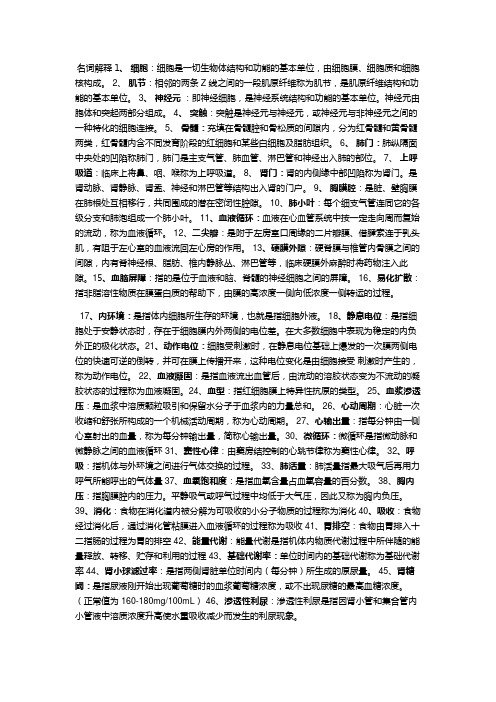
名词解释 1、细胞:细胞是一切生物体结构和功能的基本单位,由细胞膜、细胞质和细胞核构成。
2、肌节:相邻的两条 Z 线之间的一段肌原纤维称为肌节,是肌原纤维结构和功能的基本单位。
3、神经元:即神经细胞,是神经系统结构和功能的基本单位。
神经元由胞体和突起两部分组成。
4、突触:突触是神经元与神经元,或神经元与非神经元之间的一种特化的细胞连接。
5、骨髓:充填在骨髓腔和骨松质的间隙内,分为红骨髓和黄骨髓两类,红骨髓内含不同发育阶段的红细胞和某些白细胞及脂肪组织。
6、肺门:肺纵隔面中央处的凹陷称肺门,肺门是主支气管、肺血管、淋巴管和神经出入肺的部位。
7、上呼吸道:临床上将鼻、咽、喉称为上呼吸道。
8、肾门:肾的内侧缘中部凹陷称为肾门。
是肾动脉、肾静脉、肾盂、神经和淋巴管等结构出入肾的门户。
9、胸膜腔:是脏、壁胸膜在肺根处互相移行,共同围成的潜在密闭性腔隙。
10、肺小叶:每个细支气管连同它的各级分支和肺泡组成一个肺小叶。
11、血液循环:血液在心血管系统中按一定走向周而复始的流动,称为血液循环。
12、二尖瓣:是附于左房室口周缘的二片瓣膜、借腱索连于乳头肌,有阻于左心室的血液流回左心房的作用。
13、硬膜外隙:硬脊膜与椎管内骨膜之间的间隙,内有脊神经根、脂肪、椎内静脉丛、淋巴管等,临床硬膜外麻醉时将药物注入此隙。
15、血脑屏障:指的是位于血液和脑、脊髓的神经细胞之间的屏障。
16、易化扩散:指非脂溶性物质在膜蛋白质的帮助下,由膜的高浓度一侧向低浓度一侧转运的过程。
17、内环境:是指体内细胞所生存的环境,也就是指细胞外液。
18、静息电位:是指细胞处于安静状态时,存在于细胞膜内外两侧的电位差。
在大多数细胞中表现为稳定的内负外正的极化状态。
21、动作电位:细胞受刺激时,在静息电位基础上爆发的一次膜两侧电位的快速可逆的倒转,并可在膜上传播开来,这种电位变化是由细胞接受刺激时产生的,称为动作电位。
22、血液凝固:是指血液流出血管后,由流动的溶胶状态变为不流动的凝胶状态的过程称为血液凝固。
中国现代史名词解释一

一、名词解释:1、【府院之争】1916 年6 月袁世凯死后,黎元洪继任大总统,段祺瑞为国务总理,彼此争权夺利。
1917 年2 月以段祺瑞为首的亲日派为扩充实力主张对德宣战,受到以黎元洪为首的亲英美派的反对。
5 月段祺瑞指使督军团强迫国会通过宣战案未遂,要求解散国会。
黎元洪下令将段免职。
段即在天津设军务总参谋处,与黎对抗,致使北洋政府完全瘫痪。
时称为府(总统府)院(国务院)之争。
府院之争,实质上反映了美、日两国在争夺中国权益上的矛盾和中国统治集团内部争夺势力的矛盾。
2、【护法运动】孙中山领导的以拥护国会和《中华民国临时约法》为标志的革命运动。
1917年7月,孙中山发出拥护《临时约法》、恢复国会的号召。
率驻沪海军和原国会议员到广州,联合滇、桂军阀,召开“非常国会”,成立护法军政府。
选举孙中山为大元帅,出师讨段,发动护法战争。
1918年5月,孙中山在桂系军阀陆荣廷排挤下辞职赴沪。
护法军政府成为南方军阀的政权,并向北洋军政府靠拢,酝酿南北议和,护法运动遂告失败。
3、【五四运动】1919年5月4日发生于中国北京的一场爱国运动。
起因于巴黎和会上中国外交的失败。
巴黎和会决定将德国在中国山东的权益转让给日本的消息传到国内后,北京学生开展了集会、游行、罢课等活动,后得到了各地学生与各界的广泛支持,并最终演变成为全国性的罢市、罢工、罢课活动,从而形成了全国规模的爱国活动,并最终迫使北洋政府拒签了和约。
五四运动是中国旧民主主义革命的结束和新民主主义革命的开端,中国革命从此进入了新的历史阶段。
4、【五卅惨案】1925年5月初,上海内外棉纱厂工人为抗议日资本家无理开除中国工人举行罢工,日资本家枪杀青年工人、共产党员顾正红,并打伤10余人。
5月30日,上海2000余学生在租界内进行反帝宣传,声援工人斗争。
以英为首的租界当局,出动武装警察,拘捕学生。
后万余群众举行示威游行,要求释放被捕学生,遭到了英帝国主义的血腥镇压,当场死伤数十人,制造了震惊中外的“五卅惨案”。
名词解释1

名词解释1、设施园艺:设施园艺是指在露地不适于园艺作物生育的季节或地区,利用特定的保护设施与配套设备,人为地创造适于作物生育的环境空间,有计划地进行蔬菜、花卉、水果等园艺产品的安全、优质、稳产、高产生产的一种综合农业技术体系。
2、园艺设施学:进行设施园艺生产的各种设施设备的总称。
3、风障:冬、春季节在隔一定距离的蔬菜等栽培畦的北侧竖立起可挡风的屏障称为风障。
带有风障的栽培畦。
(篱笆、披风、土背)——阻挡季候风,提高栽培畦的温度。
性能:防风、增温、减少冻土深度4、阳畦:又叫冷床,它是一种以太阳辐射作为热源的建议保护设施,系由风障畦发展而来,由于比风障畦增加了床框和保温覆盖物,故保温能力显著优于风障畦。
(由风障、畦框、覆盖物组成)三种类型:抢阳畦、槽子畦和改良阳畦。
普通阳畦:畦框、风障、透明覆盖物、保温覆盖物;改良阳畦:土墙、棚架、土屋顶、玻璃窗或塑料薄膜棚面、保温覆盖物5、穴盘育苗:将种子直接播入装有营养基质的育苗穴盘中,在穴盘内培养成半成品苗或成龄苗。
6、芽苗菜:利用植物种子或其他营养贮存器官,在黑暗或光照条件下直接生长出可供食用的嫩芽、芽苗、芽球、幼梢或幼茎均可称为芽苗类蔬菜,简称芽苗菜或芽菜。
7、保温比:日光温室内的贮热面积与放热面积的比例。
8、高跨比:日光温室的高度与跨度的比例。
9、前后坡比:前坡和后坡垂直投影宽度的比例。
10、五度:角度、高度、跨度、长度、厚度四比:前后坡比、高跨比、保温比、遮阳比三材:建筑材料、透光材料、保温材料解答题1、电热温床的使用1)电热器材与功率密度、总功率及电热线条数的选择:电热系统由电热线、温度控制仪(控温仪)和交流接触器(继电器)等组成。
电热线分土壤加温线(地热线)和空气加温线,二者最好不要混用;控温仪采用农用控温仪2)布线方法:布线的行数最好为偶数3)控温仪及交流接触器与点热线的配套使用布线注意事项:1)不能接长或截断使用,不能生拉硬拽2)避免串联3)检查是否漏电4)避免电热加温线外露、交叉或打结2、地膜覆盖的优缺点:优点:①促进植株生长发育提早开花结果,增加产量②减少劳动力成本③具有增温、保水、保肥、改善土壤理化性质④提高土壤肥力⑤抑制杂草生长,减轻病害的作用缺点:1)污染环境2)使作物早衰,作物生长到中、后期产量突然下降原因:脱肥,土壤污染,空气污染解决办法:选用质量好的地膜;采用高垄栽培;施足基肥,增施优质有机肥;采用滴灌;提高栽培技术。
名词解释1
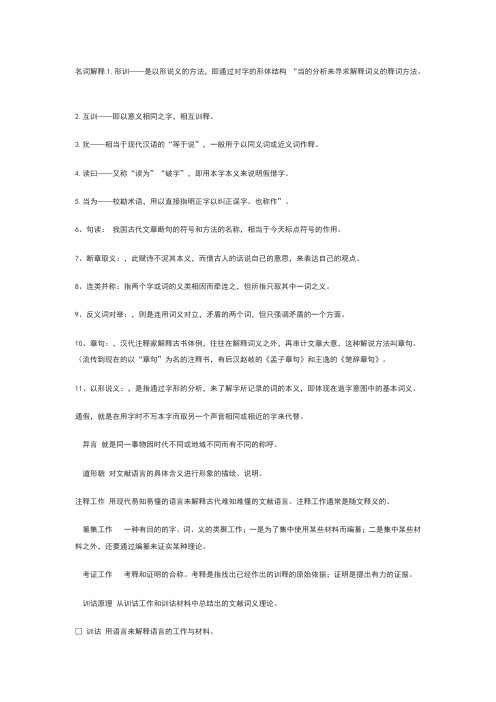
名词解释1.形训——是以形说义的方法,即通过对字的形体结构“当的分析来寻求解释词义的释词方法。
2.互训——即以意义相同之字,相互训释。
3.犹——相当于现代汉语的“等于说”,一般用于以同义词或近义词作释。
4.读曰——又称“读为”“破字”,即用本字本义来说明假借字。
5.当为——校勘术语,用以直接指明正字以纠正误字。
也称作”。
6、句读:我国古代文章断句的符号和方法的名称,相当于今天标点符号的作用。
7、断章取义:,此赋诗不泥其本义,而借古人的话说自己的意思,来表达自己的观点。
8、连类并称:指两个字或词的义类相因而牵连之,但所指只取其中一词之义。
9、反义词对举:,则是连用词义对立,矛盾的两个词,但只强调矛盾的一个方面。
10、章句:,汉代注释家解释古书体例,往往在解释词义之外,再串计文章大意,这种解说方法叫章句。
(流传到现在的以“章句”为名的注释书,有后汉赵岐的《孟子章句》和王逸的《楚辞章句》。
11、以形说义:,是指通过字形的分析,来了解字所记录的词的本义,即体现在造字意图中的基本词义。
通假,就是在用字时不写本字而取另一个声音相同或相近的字来代替。
异言就是同一事物因时代不同或地域不同而有不同的称呼。
道形貌对文献语言的具体含义进行形象的描绘、说明。
注释工作用现代易知易懂的语言来解释古代难知难懂的文献语言。
注释工作通常是随文释义的。
纂集工作一种有目的的字、词、义的类聚工作;一是为了集中使用某些材料而编纂;二是集中某些材料之外,还要通过编纂来证实某种理论。
考证工作考释和证明的合称。
考释是指找出已经作出的训释的原始依据;证明是提出有力的证据。
训诂原理从训诂工作和训诂材料中总结出的文献词义理论。
□ 训诂用语言来解释语言的工作与材料。
训诂学以前代训诂材料和前人的训诂工作为研究对象而建立起来的一门科学,是研究语言意义的理论科学。
再度注释所谓再度注释,指的是针对汉代的经注,再作进一步的解释。
《史记三家注》在南朝宋徐广《史记音义》的基础上,裴骃作了《史记集解》。
名词解释1

名词解释1、路——前后重叠成一行叫路.2、异质分组——是指分组后同一小组内的学生在体能和运动技能方面均存在差异,各组之间在整体实力上差距不大。
它是人为地将不同体能和运动技能水平的学生分成一组,或根据某种特别的需要对“异质”进行分组,从而缩小各小组之间的差距。
3、单元数学——在一个相对集中的时期内,对某个练习的内容进行系统学习或阶段学习的教学方法称之为单元教学。
4、健康——指不仅是没有疾病和不虚弱,并且在身体,心理和社会适应各方面都完善或安定的良好状态。
5、体能:指人体各器官系统的机能在身体活动中表现出来的能力。
体能包括与健康有关的体能和与运动技能有关的体能。
前者包括心肺耐力、柔韧性、肌肉力量、肌肉耐力、身体成份等。
,后者包括从事运动所需要的速度、力量、灵敏性、平衡、反应等。
其中一些体能成份即是与健康有关的体能,又是提高运动技能所需要的体能。
6、运动技能:指在体育运动中有效完成专门动作的能力,包括神经系统调节下不同肌肉群间的协调工作的能力。
作为学习领域的运动技能,要求学生学习、掌握和运用基本的运动知识和技能,形成一定的运用特长,为终身体育奠定良好的基础。
7.体育教学:是教与学的统一活动,是学生在教师有目的、有计划的指导下,积极主动地学习与掌握体育、卫生保健基础知识和基本技术、技能、锻炼身体,增强体质,促进健康,发展运动能力,培养思想品德的一种有组织的教育过程,是实现学校体育目标的基本途径之一。
8.身体素质:指人体在体育活动中所表现出来的各种机能能力。
包括力量、速度、耐力、灵敏、柔韧等。
9.完整法:是指整套动作或单个动作不分部分地进行教学的方法,它常用于比较简单的动作或者结构严谨、难以分解的动作的教学。
10.水平目标:指不同阶段学生在各个学习领域中预期达到的学习结果。
11.运动负荷:又叫运动量,包括负荷量和负荷强度。
负荷量一般学用练习的次数、时间、距离、重量来表示;负荷强度一般以练习的速度、密度、难度来表示,这两者相互影响、相互制约。
1名词解释
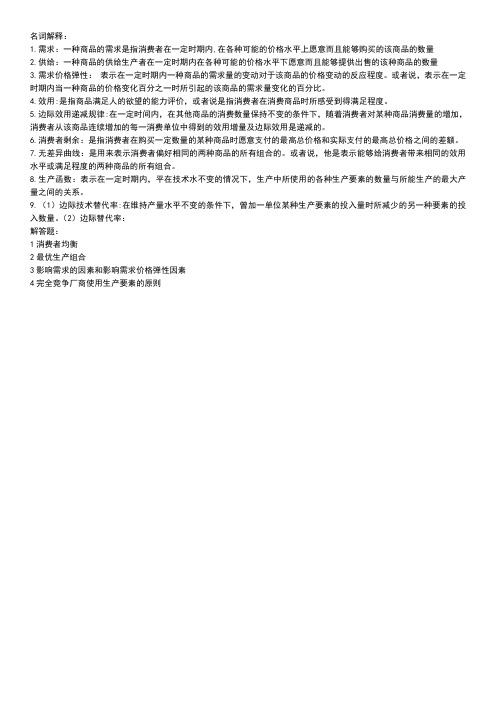
名词解释:
1.需求:一种商品的需求是指消费者在一定时期内,在各种可能的价格水平上愿意而且能够购买的该商品的数量
2.供给:一种商品的供给生产者在一定时期内在各种可能的价格水平下愿意而且能够提供出售的该种商品的数量
3.需求价格弹性:表示在一定时期内一种商品的需求量的变动对于该商品的价格变动的反应程度。
或者说,表示在一定时期内当一种商品的价格变化百分之一时所引起的该商品的需求量变化的百分比。
4.效用:是指商品满足人的欲望的能力评价,或者说是指消费者在消费商品时所感受到得满足程度。
5.边际效用递减规律:在一定时间内,在其他商品的消费数量保持不变的条件下,随着消费者对某种商品消费量的增加,消费者从该商品连续增加的每一消费单位中得到的效用增量及边际效用是递减的。
6.消费者剩余:是指消费者在购买一定数量的某种商品时愿意支付的最高总价格和实际支付的最高总价格之间的差额。
7.无差异曲线:是用来表示消费者偏好相同的两种商品的所有组合的。
或者说,他是表示能够给消费者带来相同的效用水平或满足程度的两种商品的所有组合。
8.生产函数:表示在一定时期内,平在技术水不变的情况下,生产中所使用的各种生产要素的数量与所能生产的最大产量之间的关系。
9.(1)边际技术替代率:在维持产量水平不变的条件下,曾加一单位某种生产要素的投入量时所减少的另一种要素的投入数量。
(2)边际替代率:
解答题:
1消费者均衡
2最优生产组合
3影响需求的因素和影响需求价格弹性因素
4完全竞争厂商使用生产要素的原则。
名词解释(1)

名词解释货币是在商品交换中,从商品界中自发地分化出来的,并起着一般等价物作用的特殊商品。
”价值尺度货币发挥价值尺度的职能,就是衡量和表现商品的价值。
所谓衡量商品的价值,就是评价商品包含多少社会劳动;所谓表现商品的价值,就是把社会承认的劳动量表示为一定数量的货币。
流通手段货币发挥流通手段的职能,就是充当商品交换的媒介。
货币发挥流通手段职能,使直接的物物交换变成以货币为媒介的间接交换,这种间接交换被称为商品流通。
支付手段当货币作为价值的独立形态,进行价值单方面转移时执行支付手段的职能。
贮藏手段当货币由于各种原因,暂时退出流通领域,被持有者当作独立的价值形态和社会财富的一般代表,而保存起来时,这时货币就停止流通,发挥贮藏手段职能。
世界货币当货币在国际交往中充当一般支付手段、一般购买手段和特定条件下的价值转移工具时,便执行世界货币的职能。
货币制度:简称“币制”,是一个国家以法律形式确定的该国货币流通的结构、体系与组织形式。
系统的货币制度是在资本主义经济制度产生之后形成的无限法偿:法律规定的无限支付能力,不论每次支付数额有多大,不论属于何种性质的支付(购买商品、支付劳务、结清债务、缴纳税款等),支付的对方均不得拒绝接受。
有限法偿:在一次支付行为中,超过一定的金额,收款人有权拒收;但在法定限额内,拒收则不受法律保护。
平行本位金银这两种货币均按其所含金属的实际价值流通。
其特点是,国家对两种货币不加规定,而由市场上生金银的比价自由确定金币银币的比价。
双本位金币与银币同为本位币,都可以自由铸造、流通、熔化及输出入,但二者的交换比率由国家规定的一种货币制度。
简金银这两种货币按一定的法定比价流通。
双本位制是金银复本位制的主要形式良币:实际价值高于名目价值,实际价值较高。
劣币:实际价值低于名目价值,实际价值较低。
“劣币驱逐良币”规律的定义:在两种实际价值不同,而面额价值相同(即比率相同)的通货同时流通的制度下,实际价值较高的通货(所谓良币)必然会被人们熔化、输出而退出流通领域,而实际价值较低的通货(所谓劣币)反而会充斥市场。
名词解释1
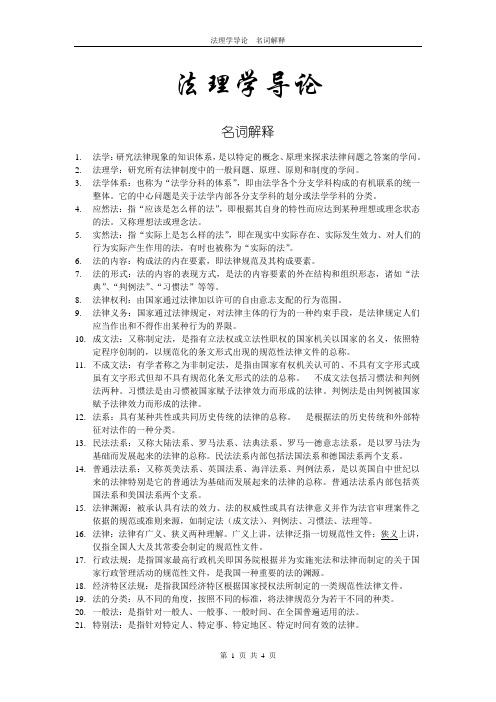
法理学导论名词解释1.法学:研究法律现象的知识体系,是以特定的概念、原理来探求法律问题之答案的学问。
2.法理学:研究所有法律制度中的一般问题、原理、原则和制度的学问。
3.法学体系:也称为“法学分科的体系”,即由法学各个分支学科构成的有机联系的统一整体。
它的中心问题是关于法学内部各分支学科的划分或法学学科的分类。
4.应然法:指“应该是怎么样的法”,即根据其自身的特性而应达到某种理想或理念状态的法。
又称理想法或理念法。
5.实然法:指“实际上是怎么样的法”,即在现实中实际存在、实际发生效力、对人们的行为实际产生作用的法,有时也被称为“实际的法”。
6.法的内容:构成法的内在要素,即法律规范及其构成要素。
7.法的形式:法的内容的表现方式,是法的内容要素的外在结构和组织形态,诸如“法典”、“判例法”、“习惯法”等等。
8.法律权利:由国家通过法律加以许可的自由意志支配的行为范围。
9.法律义务:国家通过法律规定,对法律主体的行为的一种约束手段,是法律规定人们应当作出和不得作出某种行为的界限。
10.成文法:又称制定法,是指有立法权或立法性职权的国家机关以国家的名义,依照特定程序创制的,以规范化的条文形式出现的规范性法律文件的总称。
11.不成文法:有学者称之为非制定法,是指由国家有权机关认可的、不具有文字形式或虽有文字形式但却不具有规范化条文形式的法的总称。
不成文法包括习惯法和判例法两种。
习惯法是由习惯被国家赋予法律效力而形成的法律。
判例法是由判例被国家赋予法律效力而形成的法律。
12.法系:具有某种共性或共同历史传统的法律的总称。
是根据法的历史传统和外部特征对法作的一种分类。
13.民法法系:又称大陆法系、罗马法系、法典法系、罗马—德意志法系,是以罗马法为基础而发展起来的法律的总称。
民法法系内部包括法国法系和德国法系两个支系。
14.普通法法系:又称英美法系、英国法系、海洋法系、判例法系,是以英国自中世纪以来的法律特别是它的普通法为基础而发展起来的法律的总称。
- 1、下载文档前请自行甄别文档内容的完整性,平台不提供额外的编辑、内容补充、找答案等附加服务。
- 2、"仅部分预览"的文档,不可在线预览部分如存在完整性等问题,可反馈申请退款(可完整预览的文档不适用该条件!)。
- 3、如文档侵犯您的权益,请联系客服反馈,我们会尽快为您处理(人工客服工作时间:9:00-18:30)。
3. applied linguistics: the application of linguistic theories and principles to language teaching, especially the teaching of foreign and second languages.
9. parole :Parole refers to the realization of langue in actual use.
10. competence : The ideal user’s knowledge of the rules of his language.
11. performance : The actual realization of this knowledge in linguistic communication.
5. descriptive: If a linguistic study aims to describe and analyze the language people actually use, it is said to be descriptive.
6. synchronic study: The description of language at some point of time in history is a synchronic study. (06C/ 04)
18. cultural transmission: Language is culturally transmitted. It is taught and learned from one generation to the next, rather than br 1: Introduction
1. Linguistics: Linguistics is generally defined as the scientific study of language.
2. general linguistics: The study of language as a whole.
12. language : Language is a system of arbitrary vocal symbols used for human communication.
13. design features : Design features refer to the defining properties of human language that distinguish it from any animal system of communication.
4. prescriptive: If linguistic study aims to lay down rules for “correct and standard” behavior in using language, i.e. to tell people what they should and should not say, it is said to be prescriptive.
14. arbitrariness: Arbitrariness refers to no logical connection between meaning and sound.
15. productivity: Users can understand and produce sentences that they have never heard before.
16. duality: Language consists of two sets of structure, with lower lever of sound, which is meaningless, and the higher lever of meaning.
17. displacement: Language can be used to refer to the contexts removed from the immediate situation of the speaker no matter how far away from the topic of conversation in time or space. (04)
7. diachronic study: The description of a language as it changes through time is a diachronic study. (06C)
8. langue: Lange refers to the abstract linguistic system shared by all the members of a speech community.
